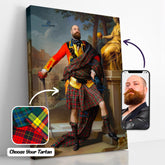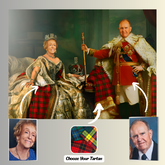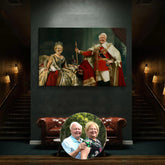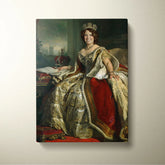-
Clan Buchanan Old Set Weathered Tartan Polo Shirt HW58 - Buchanan Old Set Weathered Tartan
Clan Buchanan Old Set Weathered Tartan Polo Shirt HW58 Description: Crafted in 100% polyester with your own design which combines comfort and vogue. This shirt has some'great features, it has 3 buttons, elastic collar and cuffs. 12.35 Oz. Made from polyester fabric. 3 buttons,...- $38.25
- $38.25
- Unit price
- per
- Buchanan Old Set Weathered Tartan
-
Clan Buchanan Old Dress Tartan Polo Shirt - Royal Coat Of Arms Style OG20 - Buchanan Old Dress Tartan
Clan Buchanan Old Dress Tartan Polo Shirt - Royal Coat Of Arms Style OG20 Description: Crafted in 100% polyester with your own design which combines comfort and vogue. This shirt has some'great features, it has 3 buttons, elastic collar and cuffs. 12.35 Oz. Made...- $38.25
- $38.25
- Unit price
- per
- Buchanan Old Dress Tartan
-
Clan Buchanan Old Dress Tartan Polo Shirt - Lion Rampant And Celtic Thistle Style FX40 - Buchanan Old Dress Tartan
Clan Buchanan Old Dress Tartan Polo Shirt - Lion Rampant And Celtic Thistle Style FX40 Description: Crafted in 100% polyester with your own design which combines comfort and vogue. This shirt has some'great features, it has 3 buttons, elastic collar and cuffs. 12.35 Oz....- $38.25
- $38.25
- Unit price
- per
- Buchanan Old Dress Tartan
-
Clan Buchanan Old Dress Tartan Polo Shirt - Alba Celtic Style DI73 - Buchanan Old Dress Tartan
Clan Buchanan Old Dress Tartan Polo Shirt - Alba Celtic Style DI73 Description: Crafted in 100% polyester with your own design which combines comfort and vogue. This shirt has some'great features, it has 3 buttons, elastic collar and cuffs. 12.35 Oz. Made from polyester...- $38.25
- $38.25
- Unit price
- per
- Buchanan Old Dress Tartan
-
Clan Buchanan Old Dress Tartan Polo Shirt XV51 - Buchanan Old Dress Tartan
Clan Buchanan Old Dress Tartan Polo Shirt XV51 Description: Crafted in 100% polyester with your own design which combines comfort and vogue. This shirt has some'great features, it has 3 buttons, elastic collar and cuffs. 12.35 Oz. Made from polyester fabric. 3 buttons, elastic...- $38.25
- $38.25
- Unit price
- per
- Buchanan Old Dress Tartan
-
Clan Buchanan Modern Tartan Polo Shirt Viking Wolf RG99 - Buchanan Modern Tartan
Clan Buchanan Modern Tartan Polo Shirt Viking Wolf RG99 Description: Crafted in 100% polyester with your own design which combines comfort and vogue. This shirt has some'great features, it has 3 buttons, elastic collar and cuffs. 12.35 Oz. Made from polyester fabric. 3 buttons,...- $38.25
- $38.25
- Unit price
- per
- Buchanan Modern Tartan
-
Clan Buchanan Modern Tartan Polo Shirt Half of Me - Cross Style QX74 - Buchanan Modern Tartan
Clan Buchanan Modern Tartan Polo Shirt Half of Me - Cross Style QX74 Description: Crafted in 100% polyester with your own design which combines comfort and vogue. This shirt has some'great features, it has 3 buttons, elastic collar and cuffs. 12.35 Oz. Made from...- $38.25
- $38.25
- Unit price
- per
- Buchanan Modern Tartan
-
Clan Buchanan Modern Tartan Polo Shirt - Royal Coat Of Arms Style BP30 - Buchanan Modern Tartan
Clan Buchanan Modern Tartan Polo Shirt - Royal Coat Of Arms Style BP30 Description: Crafted in 100% polyester with your own design which combines comfort and vogue. This shirt has some'great features, it has 3 buttons, elastic collar and cuffs. 12.35 Oz. Made from...- $38.25
- $38.25
- Unit price
- per
- Buchanan Modern Tartan
-
Clan Buchanan Modern Tartan Polo Shirt - Lion Rampant And Celtic Thistle Style VB10 - Buchanan Modern Tartan
Clan Buchanan Modern Tartan Polo Shirt - Lion Rampant And Celtic Thistle Style VB10 Description: Crafted in 100% polyester with your own design which combines comfort and vogue. This shirt has some'great features, it has 3 buttons, elastic collar and cuffs. 12.35 Oz. Made...- $38.25
- $38.25
- Unit price
- per
- Buchanan Modern Tartan
-
Clan Buchanan Modern Tartan Polo Shirt - Believe In Me Style ZZ59 - Buchanan Modern Tartan
Clan Buchanan Modern Tartan Polo Shirt - Believe In Me Style ZZ59 Description: Crafted in 100% polyester with your own design which combines comfort and vogue. This shirt has some'great features, it has 3 buttons, elastic collar and cuffs. 12.35 Oz. Made from polyester...- $38.25
- $38.25
- Unit price
- per
- Buchanan Modern Tartan
-
Clan Buchanan Modern Tartan Polo Shirt - Alba Celtic Style IP25 - Buchanan Modern Tartan
Clan Buchanan Modern Tartan Polo Shirt - Alba Celtic Style IP25 Description: Crafted in 100% polyester with your own design which combines comfort and vogue. This shirt has some'great features, it has 3 buttons, elastic collar and cuffs. 12.35 Oz. Made from polyester fabric....- $38.25
- $38.25
- Unit price
- per
- Buchanan Modern Tartan
-
Clan Buchanan Modern Tartan Polo Shirt GZ31 - Buchanan Modern Tartan
Clan Buchanan Modern Tartan Polo Shirt GZ31 Description: Crafted in 100% polyester with your own design which combines comfort and vogue. This shirt has some'great features, it has 3 buttons, elastic collar and cuffs. 12.35 Oz. Made from polyester fabric. 3 buttons, elastic collar...- $38.25
- $38.25
- Unit price
- per
- Buchanan Modern Tartan
-
Clan Buchanan Modern Clan - Military Polo Shirt IS85 - Buchanan Modern Tartan
Clan Buchanan Modern Clan - Military Polo Shirt IS85 Description: Crafted in 100% polyester with your own design which combines comfort and vogue. This shirt has some'great features, it has 3 buttons, elastic collar and cuffs. 12.35 Oz. Made from polyester fabric. 3 buttons,...- $38.25
- $38.25
- Unit price
- per
- Buchanan Modern Tartan
-
Clan Buchanan Hunting Tartan Polo Shirt Viking Wolf HV86 - Buchanan Hunting Tartan
Clan Buchanan Hunting Tartan Polo Shirt Viking Wolf HV86 Description: Crafted in 100% polyester with your own design which combines comfort and vogue. This shirt has some'great features, it has 3 buttons, elastic collar and cuffs. 12.35 Oz. Made from polyester fabric. 3 buttons,...- $38.25
- $38.25
- Unit price
- per
- Buchanan Hunting Tartan
-
Clan Buchanan Hunting Tartan Polo Shirt Half of Me - Cross Style OF55 - Buchanan Hunting Tartan
Clan Buchanan Hunting Tartan Polo Shirt Half of Me - Cross Style OF55 Description: Crafted in 100% polyester with your own design which combines comfort and vogue. This shirt has some'great features, it has 3 buttons, elastic collar and cuffs. 12.35 Oz. Made from...- $38.25
- $38.25
- Unit price
- per
- Buchanan Hunting Tartan
-
Clan Buchanan Hunting Tartan Polo Shirt - Royal Coat Of Arms Style FN72 - Buchanan Hunting Tartan
Clan Buchanan Hunting Tartan Polo Shirt - Royal Coat Of Arms Style FN72 Description: Crafted in 100% polyester with your own design which combines comfort and vogue. This shirt has some'great features, it has 3 buttons, elastic collar and cuffs. 12.35 Oz. Made from...- $38.25
- $38.25
- Unit price
- per
- Buchanan Hunting Tartan
-
Clan Buchanan Hunting Tartan Polo Shirt - Lion Rampant And Celtic Thistle Style NE36 - Buchanan Hunting Tartan
Clan Buchanan Hunting Tartan Polo Shirt - Lion Rampant And Celtic Thistle Style NE36 Description: Crafted in 100% polyester with your own design which combines comfort and vogue. This shirt has some'great features, it has 3 buttons, elastic collar and cuffs. 12.35 Oz. Made...- $38.25
- $38.25
- Unit price
- per
- Buchanan Hunting Tartan
-
Clan Buchanan Hunting Tartan Polo Shirt - Believe In Me Style UI84 - Buchanan Hunting Tartan
Clan Buchanan Hunting Tartan Polo Shirt - Believe In Me Style UI84 Description: Crafted in 100% polyester with your own design which combines comfort and vogue. This shirt has some'great features, it has 3 buttons, elastic collar and cuffs. 12.35 Oz. Made from polyester...- $38.25
- $38.25
- Unit price
- per
- Buchanan Hunting Tartan
-
Clan Buchanan Hunting Tartan Polo Shirt - Alba Celtic Style ML11 - Buchanan Hunting Tartan
Clan Buchanan Hunting Tartan Polo Shirt - Alba Celtic Style ML11 Description: Crafted in 100% polyester with your own design which combines comfort and vogue. This shirt has some'great features, it has 3 buttons, elastic collar and cuffs. 12.35 Oz. Made from polyester fabric....- $38.25
- $38.25
- Unit price
- per
- Buchanan Hunting Tartan
-
Clan Buchanan Hunting Tartan Polo Shirt ET73 - Buchanan Hunting Tartan
Clan Buchanan Hunting Tartan Polo Shirt ET73 Description: Crafted in 100% polyester with your own design which combines comfort and vogue. This shirt has some'great features, it has 3 buttons, elastic collar and cuffs. 12.35 Oz. Made from polyester fabric. 3 buttons, elastic collar...- $38.25
- $38.25
- Unit price
- per
- Buchanan Hunting Tartan
Ex: Your Tartan + Product
Popular Products
Turn Me Royal Personalized Portrait from Your Photo, Custom Tartan. Custom Canvas Wall Art as Gift for Men
- From $32.45
- From $32.45
- Unit price
- / per
Royalty Couple Personalized Portrait from Your Photo, Custom Tartan. Custom Canvas Wall Art
- From $47.45
- From $47.45
- Unit price
- / per
The Queen Personalized Portrait from Your Photo, Custom Tartan. Custom Canvas Wall Art as Gift for Women
- From $32.45
- From $32.45
- Unit price
- / per
List Of Tartan
-
Clan A
- Abercrombie Tartan
- Aberdeen Tartan
- Abernethy Tartan
- Adair Tartan
- Adam Tartan
- Ayrshire Tartan
- Agnew Tartan
- Aikenhead Tartan
- Ainslie Tartan
- Aiton Tartan
- Allan Tartan
- Alexander Tartan
- Allardice Tartan
- Allison Tartan
- Anderson Tartan
- Angus Tartan
- Anstruther Tartan
- Arbuthnot Tartan
- Armstrong Tartan
- Arnott Tartan
- Auchinleck Tartan
- Ayrshire Tartan
-
Clan B
- Baillie Tartan
- Bain Tartan
- Baird Tartan
- Balfour Tartan
- Bannatyne Tartan
- Bannerman Tartan
- Barclay Tartan
- Baxter Tartan
- Beaton Tartan
- Bell Tartan
- Belshes Tartan
- Bethune Tartan
- Beveridge Tartan
- Binning Tartan
- Bisset Tartan
- Blackadder Tartan
- Blackstock Tartan
- Black Watch Tartan
- Blair Tartan
- Blane Tartan
- Blyth Tartan
- Borthwick Tartan
- Boswell Tartan
- Bowie Tartan
- Boyd Tartan
- Boyle Tartan
- Brisbane Tartan
- Brodie Tartan
- Brown/ Broun Tartan
- Bruce Tartan
- Buccleuch Tartan
- Buchan Tartan
- Buchanan Tartan
- Burnett Tartan
- Burns Tartan
- Butter Tartan
- Byres Tartan
-
Clan C
- Cairns Tartan
- Calder Tartan
- Callander Tartan
- Cameron Tartan
- Campbell Tartan
- Campbell of Breadalbane Tartan
- Campbell of Cawdor Tartan
- Carmichael Tartan
- Carnegie Tartan
- Carruthers Tartan
- Cathcart Tartan
- Chalmers Tartan
- Charteris Tartan
- Chattan Tartan
- Cheyne Tartan
- Chisholm Tartan
- Christie Tartan
- Clark Tartan
- Clelland Tartan
- Clephan Tartan
- Clergy Tartan
- Cochrane Tartan
- Cockburn Tartan
- Colquhoun Tartan
- Colville Tartan
- Cooper Tartan
- Couper Tartan
- Craig Tartan
- Cranstoun Tartan
- Crawford Tartan
- Crichton Tartan
- Crief District Tartan
- Crosbie Tartan
- Cumming Tartan
- Cunningham Tartan
- Currie Tartan
- Clan D
- Clan E
- Clan F
- Clan G
- Clan H
- Clan I
- Clan J
- Clan K
- Clan L
-
Clan M
- Maitland Tartan
- Malcolm Tartan
- Mar Tartan
- Marjoribanks Tartan
- Maxtone Tartan
- Matheson Tartan
- Maule Tartan
- Maxwell Tartan
- Meldrum Tartan
- Melville Tartan
- Menzies Tartan
- Mercer Tartan
- Middleton Tartan
- Moffat Tartan
- Moncrieffe Tartan
- Montgomery Tartan
- Monypenny Tartan
- Moncreiffe Tartan
- Monteith Tartan
- Morrison Tartan
- Mouat Tartan
- Moubray Tartan
- Mow Tartan
- Muir_More Tartan
- Muirhead Tartan
- Munro Tartan
- Murray Tartan
- Murray of Atholl Tartan
-
Clan Mc/Mac
- MacAlister Tartan
- MacArthur Tartan
- MacAlpine Tartan
- MacAulay Tartan
- MacBain Tartan
- MacBean Tartan
- MacBeth Tartan
- MacCallum Tartan
- MacCraig Tartan
- MacColl Tartan
- MacCorquodale Tartan
- MacDiarmid Tartan
- MacDonald Tartan
- MacDonald of Clanranald Tartan
- MacDonald of Sleat Tartan
- MacDonnell of Glengarry Tartan
- MacDonnell of Keppoch Tartan
- MacDougall Tartan
- MacDowall Tartan
- MacDuff Tartan
- MacEwen_MacEwan Tartan
- MacEdward Tartan
- MacFarlane Tartan
- MacGill Tartan
- MacGillivray Tartan
- MacGregor Tartan
- MacGowan (McGowan) Tartan
- MacHardy Tartan
- MacIan Tartan
- MacInnes Tartan
- MacIntyre Tartan
- MacKay Tartan
- MacKillop Tartan
- MacKellar Tartan
- Mackinlay Tartan
- MacKenzie Tartan
- Mackie Tartan
- MacKinnon Tartan
- MacKintosh / MacIntosh Tartan
- MacLeod Tartan
- MacMillan Tartan
- MacNab Tartan
- MacNaughton Tartan
- MacNeil / MacNeill Tartan
- MacNeil of Colonsay Tartan
- MacNicol Tartan
- MacPhail Tartan
- MacPhee_MacFie Tartan
- MacPherson Tartan
- MacQuarrie Tartan
- MacQueen Tartan
- MacRae Tartan
- MacRow Tartan
- MacSporran Tartan
- MacTaggart Tartan
- MacTavish Tartan
- MacThomas Tartan
- McCorquodale Tartan
- McCulloch Tartan
- McFadzen Tartan
- McGeachie Tartan
- McIver Tartan
- McKerrell Tartan
- Clan N
- Clan O
- Clan P
- Clan R
-
Clan S
- Sandilands Tartan
- Scott Tartan
- Scrymgeour Tartan
- Selkirk Tartan
- Sempill Tartan
- Seton Tartan
- Shaw Tartan
- Shepherd Tartan
- Sinclair Tartan
- Skene Tartan
- Skirving Tartan
- Smith Tartan
- Somerville Tartan
- Spalding Tartan
- Spens Tartan
- Spottiswood Tartan
- Stevenson Tartan
- Stewart Tartan
- Stewart of Appin Tartan
- Stirling Tartan
- Strachan Tartan
- Straiton Tartan
- Strange Tartan
- Strathclyde District Tartan
- Stuart of Bute Tartan
- Sutherland Tartan
- Swinton Tartan
- Clan T
- Clan U W Y
- Request Your Clan
Clan Buchanan (Buchanan Tartan)
1. About Clan Buchanan (Buchanan Tartan)
2. Clan Buchanan History (Buchanan Tartan)
Since 1225, when the Earls of Lennox granted territory to Sir Absalon of Buchanan—known at the time as "clericus meus" or "the clergyman"—the Buchanan name has been rooted in the areas bordering Loch Lomond.
A 19th century depiction of a Buchanan clansman by R.R. McIan
'Buth chanain' is Gaelic for the 'House of the Canon,' indicating that the first Buchanan's may have been a family dedicated to the service of the ancient Celtic church or may have had a pre-charter, hereditary clerical tenure, lends validity to such a claim.
The clan can also be traced back to Anselan O Kyan, a King of Ulster's son who arrived in Argyll around 1016. He was given the Buchanan estates, which are located to the east of Loch Lomond, in exchange for his assistance against the Danes.
Additionally, it has been asserted that Gilbert, the Earl of Lennox's seneschal, was the benefactor and that the holdings were in Stirlingshire.
These territories were granted baronial powers in 1282 by a charter granted to Morris of Buchanan, who also possessed the little island of Clarinch, which later served as the clan battle cry.
The Bruce family's dominance in the post-Banockburn era was ensured by the Buchanans' support of the Bruce during the fight of independence. With a notable exception, the Buchanan shield and the Royal Arms of Scotland are nearly identical.
In the Buchanan form of the arms, the lion and the double fleur-de-lis treasure are black instead of red. This is supposed to be a reference to Sir Walter Buchanan's marriage to Murdoch, Duke of Albany and Regent of Scotland, only daughter.
The regent was to be executed by his cousin James I in 1425, have his properties seized, and have his son's unmarried death end the line of the regent's family.
According to legend, the Buchanan arms' coloring also symbolizes sadness for the loss of their position as the disinherited family's closest kin.
The Buchanan's of Arnprior, known as the "Kings of Kippen," had estates in Kippen, Perthshire, and were more descendants of this principal line.
This well-known moniker is based on a Walter Scott tale in which James V, who liked to tour his territories in disguise, arrived at Arnprior without being recognized.
Given his standing, he was greeted with a level of hospitality that was hardly adequate. The Laird was dining and could not be disturbed, he was informed.
The James V in disguise asked the doorman to inform the 'King of Kippen' that:
"Ballengreich's Goodman is here to feast,"
Buchanan asked for pardon because he understood that these words meant he was in the presence of actual monarchy.
John Michael Baillie-Hamilton Buchanan was appointed Chief of the Name and Arms of Buchanan in August 2018. He is the Clan's first Chief in 337 years.
John Michael Baillie-Hamilton Buchanan of that Ilk and Arnprior Chief of the Name and Arms of Buchanan is his whole name.
3. Clan Buchanan Tartans
One of the most recognizable and well-liked tartans of the day is the Buchanan. Its unique asymmetric sett, which lends it its appeal, may, in actuality, be the result of an error. In the year 1845, McIan was painting the Clans of Scotland's Victorian drawings.
Thought to have been painting on a symmetrical sample, McIan, who was renowned for his accuracy, painted it asymmetrically, which immediately became the sett.
'Modern' refers to the dye tones, which are typically darker, whilst 'ancient' colors would typically be lighter.
Threadcount: B/8 K4 G12 B/8 K4 G12 K4 B/8 K4 R16 W4 R16 K4 B/8 K4 Y12 K4 Y12 K4
Buchanan Ancient
Buchanan Modern
The Vestiarium Scoticum is where the contemporary Hunting Buchanan tartan is derived. The sett appears to have been unknown prior to this and resembles a design by Sobieski Stewart. But it is still only about 200 years old.
Modern refers to the dye colors, which are typically darker.
LB/8 T20 G20 T20 Y4 T20 G20 B20 G8 B20 G20 T40 Threadcount
Buchanan Hunting Modern
Before McIan's asymmetrical painting gaffe, the Buchanan old sett was thought to be the accurate version.
While "modern" refers to darker dye colors, "ancient" refers to dye tints that are often lighter. The term "weathered" describes dye colors that attempt to replicate the hues of a tartan fragment discovered buried on a battlefield.
Threadcount LB/8 G64 K4 K8 K4 K8 K8 Y16 K4 K8 K8 K8 R64 W/8
Buchanan Old Sett Ancient
Buchanan Old Sett Weathered
4. Clan Buchanan Crest & Coats of Arms
4.1 Clan Buchanan Crest
Worn by all of the name and ancestry
4.2 Clan Buchanan Coat of Arms
Observations on coats of arms
With the exception of civic or corporate arms, a person is granted a coat of arms under Scottish heraldic law. A 'family coat of arms' does not exist.
With the exclusions listed above, the weapons depicted below are personal weapons. The only person authorized to use these weapons is the grantee.
Buchanan Society Shield
Arms of John Buchanan of that Ilk
BUCHANAN of that Ilk
Or, a lion rampant, Sable, armed and languaged, Gules, within a double tressure, flory counterflory, of the second
Charles Alexander Buchanan's Touch Arms
The second son of Fintona, County Tyrone resident Robert Buchanan, who was the bearer of these arms. The family appears to be a descendant of William Buchanan of Blairvockie and lived for a while in Ireland. By way of Walter Buchanan of Spittal, the Buchanans of Blairvockie are cadets of Spittal.
George Buchanan of that ilk, who wed Elizabeth Preston and was the father of John Buchanan, the last laird of Buchanan, had a brother named Walter Buchanan of Spittal. The Buchanan Book author A.W.P. Buchanan is related to the family, and members of the family moved to Canada.
Lyon Register Volume 30 - Page 24 - 3 March 1932 contains a record of the arms.
5. Clan Buchanan Places & People
5.1 Clan Buchanan Places
The following places are associated with Clan Buchanan, either historically or currently.
5.1.1 Buchanan Auld House, Stirlingshire
The Chiefs of Clan Buchanan, who controlled the house and the grounds around it, held court in Buchanan Auld House. After John Buchanan's death in 1682, Clan Graham purchased the lands that the Buchanans had owned since approximately 1230. Ruins are all that is left of Buchanan Auld House.
5.1.2 Buchanan Monument, Killearn
The George Buchanan Monument was built in 1788 in honor of the poet and historian who lived from 1506 to 1582.
5.1.3 Craigend Castle, Milngavie
The Smith family acquired the Craigend estate in the 1600s. After John Smith's death in 1812, his son James expanded and redesigned the house he had built in the 18th century into a mansion.
When Sir Andrew Buchanan purchased Craigend in 1851, it came under the control of the Buchanan family and stayed there until the early 20th century. Currently, Craigend Castle is in ruins.
5.1.4 Dunglass Castle, West Dunbartonshire
Initially constructed in 1380 by the Colquhoun family is Dunglass Castle. The castle was in ruins by the 1730s, and much of the stone was removed to repair a nearby wharf and construct other structures.
When Andrew Buchanan of Auchentorlie acquired the castle in 1812, this custom was abolished.
5.2 Clan Buchanan People
5.2.1 George Buchanan (1506 – 1582)
The protestant reformer and poet was born in 1506 in Killearn, Stirlingshire. From 1520 onward, a portion of his education was spent in Paris, where he traveled much on the continent and began his literary career in the midst of the Reformation's intellectual upheaval.
Only two years after his return to Scotland as a Calvinist convert, in April 1562, he was chosen to serve as the young Mary, Queen of Scots's classicals tutor.
Despite the royal favor he had acquired, his literary talents were focused on his profane criticisms of the Queen, which were allegedly penned in the most prosaic and exquisite Latin.
The historical perspectives we have of this time period have been tainted by these tracts, which have been around for centuries.
He was given credit for the infant James VI's academic prowess because he was chosen to be the monarch's preceptor and teacher when Mary abdicated.
However, he also turned the young James VI against his mother and contributed to the development of a warped personality.
5.2.2 Ken Buchanan (born 28 June 1945)
A former lightweight professional boxer, Ken Buchanan. Buchanan, who was born in Edinburgh in 1945, began his professional career in 1965 before winning the undisputed title of lightweight in 1971.
In 2000, Ken Buchanan became a member of the International Boxing Hall of Fame. He is recognized as one of the greatest boxers to ever represent Britain.
6. Associated Names
The following names are considered septs or associated names of Clan Buchanan:
Calman, Colman, Cormack, Cousland, Dewar, Dove, Dow, Gibb, Gibbon, Gibson, Gilbert, Gilbertson, Harper, Harperson, Leavy, Lennie, Lenny, MacAldonich, MacAlman, MacAslan, MacAslin, MacAuselan, MacAuslan, MacAusland, MacAuslane, MacAlman, MacAlmont, MacAmmond, MacAsland, MacChruiter, MacCalman, MacColman, MacCormack, MacCubbin, MacCubbing, MacCubin, MacGeorge, MacGibbon, MacGreuisich, MacGubbin, MacInally, MacIndeor, MacIndoe, MacKinlay, MacKinley, MacMaster, MacMaurice, MacMurchie, MacMurchy, MacNeur, MacNuir, MacNuyer, MacQuattie, MacWattie, MacWhirter, Masters, Masterson, MacCaslin, Morrice, Morris, Morrison, Murchie, Murchison, Richardson, Risk, Rusk, Ruskin, Spittal, Spittel, Walter, Walters, Wason, Waters, Watson, Watt, Watters, Weir, Yuill, Yool, Yule, and Zuill
- Choosing a selection results in a full page refresh.
















































